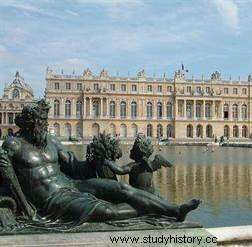 The Palace of Versailles is a centerpiece of world heritage and one of the most visited historical monuments in the world, welcoming around 6.5 million visitors a year. Symbol of the power of the Sun King and of France in the Grand Siècle, Louis XIV realized his dream of stone, gold, greenery, water and light in Versailles, bringing together all the forces of national production. But this decision to build his palace had far more serious consequences than was thought at the time. This shifting of the seat of power was a retreat out of Paris, the city thus becoming freer and bolder.
The Palace of Versailles is a centerpiece of world heritage and one of the most visited historical monuments in the world, welcoming around 6.5 million visitors a year. Symbol of the power of the Sun King and of France in the Grand Siècle, Louis XIV realized his dream of stone, gold, greenery, water and light in Versailles, bringing together all the forces of national production. But this decision to build his palace had far more serious consequences than was thought at the time. This shifting of the seat of power was a retreat out of Paris, the city thus becoming freer and bolder.
History of Versailles before the Sun King
The name "Versailles" appears for the 1 era times in 1038 in a charter of the Abbey of St Père de Chartes. Hugo de Versaillis is one of the signatories. At the end of the Hundred Years War, the small town was in a sad state:the houses were devastated, abandoned, the castle in ruins. The name of a small town:Versailles-aux-bourgs-de-Galie appeared in 1472. Then in 1475, Gilles de Versailles, Lord of Versailles ceded his rights to Trianon to the Abbot of Saint Germain. This is the 1 era times Trianon is mentioned. It was a small village bought and then destroyed by Louis XI who wanted to build a royal estate on this land with a rest house. The king wanted to flee Paris and take advantage of this place far from etiquette:it was the First Royal Caprice of Versailles.
Versailles is the 1 era stage between Paris and Brittany. But the land is occupied by uncultivated fields, surrounded by marshes. It is cold there, everything is dark and wild. The place is unhealthy (due to the constant humidity), epidemics of fever cause the population to drop considerably, so that animals soon outnumber humans. In 1561, the estate was sold to the financial secretary of Charles IX, Martial de Loménie, an estate which would reach 150 hectares. But in 1572, Loménie was killed during Saint Barthélémy and the rumor goes:“Catherine de Medici had Loménie strangled in the interest of the Count of Retz to give him the Château de Versailles » …
The following year, Albert de Gondi, Count of Retz became the owner of the Palace and Estate of Versailles by buying the whole thing for 35,000 pounds. From this date, we can say that Versailles begins to be really known and appreciated by the future kings:in 1578 Henri de Navarre stays there from July 7 to 9, he returns there in 1604 and 1609. The future dolphin Louis XIII y makes his 1 st hunting in 1607 (he was only 6 years old), then in 1616 Albert de Gondi ceded the seigneury to his son Jean François.
A little later, on returning from hunting parties, Louis XIII stopped with his friends in the mansion almost abandoned by the Gondi family. Tired of sleeping uncomfortably, he decided in 1623 to build in the middle of the forests and at the top of a hill surrounded by marshes, a small house in brick, stone and slate. He made this rustic construction his favorite hunting spot. Louis XIII bought the surrounding land in order to obtain an area of 40 hectares.
His little castle stood at the bottom of the current Cour de Marbre, the main building measured 24m long by 6m deep, with 2 low wings on each side. The whole did not exceed 25m x 27m. The king's apartment was composed of a small gallery, then 4 rooms with walls covered with tapestry, the king's bedroom in the center, later this location will be the bed of Louis XIV. It was an immense pleasure for the king to sleep for the first time at Versailles in March 1624, in the midst of his people. He was himself, this house was his refuge.
Louis XIII will add a tennis court to his home:Philibert Leroy, architect, will make a large rectangular building 33m by 14m, side walls 1.30 m thick, the three galleries indicate that it is a game within, the floor covered with freestone tiles. These elements were discovered by a team from Inrap, during excavations carried out in the courtyard of the Grand Commun, the house of the paumier (the one who manages and maintains the room) was also found.
Louis XIII bought the estate of Versailles from Jean François de Gondi, uncle of the Cardinal de Retz in April 1632.
Tradition has it that at the top of the plateau of Versailles, in the very place of the current castle, stood a windmill and it was said:"a miller reigned where Louis XIV reigned .
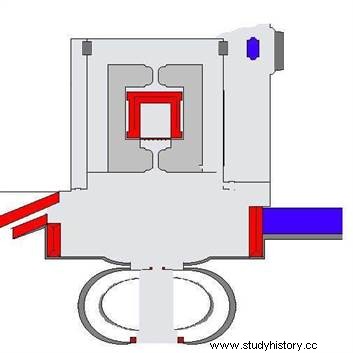 The king acquired this castle to demolish it and extend the domain of the royal residence. He bought new land and expanded his hunting grounds. The first pavilion became too small and in May 1631, work began under the direction of Philibert Le Roy, they were completed in 1634. Louis XIII entered his new apartments. From 1636, the king often stayed there, took advantage of the comfort of his new house as well as the gardens, laid out in the French style, decorated with arabesques and interlacing.
The king acquired this castle to demolish it and extend the domain of the royal residence. He bought new land and expanded his hunting grounds. The first pavilion became too small and in May 1631, work began under the direction of Philibert Le Roy, they were completed in 1634. Louis XIII entered his new apartments. From 1636, the king often stayed there, took advantage of the comfort of his new house as well as the gardens, laid out in the French style, decorated with arabesques and interlacing.
The first traces of the gardens appear in the 1630s, to the west of the castle. Around a small circular basin, a bed of boxwood embroidery was divided into compartments. In 1639, the team traced a central aisle from the castle terrace to the west in the hollow of a valley, on a piece of water which would become the basin of Apollo under Louis XIV. This garden was simple and charming, following the natural slope of the land. These gardens remained almost intact until the transformations ordered by Louis XIV, in particular the main axes which form the essential lines of the gardens.
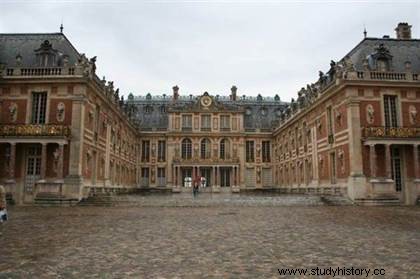 In 1643, Louis XIII declared:"if God restores my health, as soon as my dolphin is old enough to ride a horse and of the age of majority I will put him in my place, and will retire to Versailles with four of our fathers to speak to me of divine things ". He felt death approaching. On May 14, he passed away. Versailles then ceased to be a royal residence for almost 18 years.
In 1643, Louis XIII declared:"if God restores my health, as soon as my dolphin is old enough to ride a horse and of the age of majority I will put him in my place, and will retire to Versailles with four of our fathers to speak to me of divine things ". He felt death approaching. On May 14, he passed away. Versailles then ceased to be a royal residence for almost 18 years.
The Palace of Versailles in the 17th century
Louis XIV, suspicious of the capital following the episode of the Fronde, wanted to settle away from Paris. He is therefore looking for a large space to build a castle. He completed his 1 era visit to Versailles in 1651 and fell in love with it. Annoyed by his visit to the castle of Vaux-le-Vicomte in 1659 before its completion, Louis XIV had only one idea:to build a castle that had no possible comparison in the kingdom, or even in Europe, a building devoting the greatness of the king and his reign.
The plan of the castle is studied to highlight the sovereign, the royal bedroom is located in the center of the palace and on a main axis that starts from the statue of the king in the courtyard entrance and which is extended by the Green Carpet and the Grand Canal. This castle was initially only used to protect the love of the king, the first mistress to visit the place was Louise de La Vallière. "The Château de Carte will become the Royal Bachelor's".
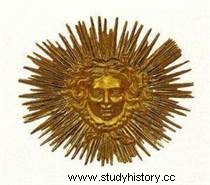 It's only in 1660 that Louis XIV took his new wife, Queen Marie Thérèse, there. From 1661, the enlargements of Versailles began. From 1661 to 1662, the king spent one million one hundred thousand pounds. He decided to build, instead of his father's hunting lodge, one of the most marvelous palaces in Europe, which triggered criticism from the courtiers.
It's only in 1660 that Louis XIV took his new wife, Queen Marie Thérèse, there. From 1661, the enlargements of Versailles began. From 1661 to 1662, the king spent one million one hundred thousand pounds. He decided to build, instead of his father's hunting lodge, one of the most marvelous palaces in Europe, which triggered criticism from the courtiers.
Established on inhospitable land, the ground was uneven, sandy, marshy. It is necessary to drain the ground, to level it, to raze the domain of Trianon. Saint Simon said:"Versailles, ungrateful place, sad, without sight, without wood, without water, without land, because everything is quicksand and swamp, without air, therefore not good .
The construction of the Palace of Versailles
Louis XIV hired the best architects, decorators, gardeners, fountain engineers to transform the buildings. Louis Le Vau was commissioned to rebuild the Communs, Charles Errard and Noël Coypel began the work of decorating the apartments with great luxury, taking up the theme of the sun, omnipresent in Versailles, Le Nôtre created the Orangery and the Menagerie. The gardens increased in size and were adorned with sculptures by Girardon and Le Hongre. Versailles was then only a pleasure residence with parties given in the gardens.
Proud of his personal home, Louis wanted to delight his guests. The apartments of his guests were furnished, which was considered exceptional. Colbert said:“His Majesty has everyone fed and even wood and candles supplied in all the rooms, which has never been done in royal houses ". Let us recall Colbert's famous letter:"During the time that Your Majesty has spent such large sums on this house, you have neglected the Louvre, which is assuredly the most superb palace there is in the world. O what a pity that the greatest king was measured by the yardstick of Versailles ! »
In May 1664, the first festivities were given at the castle:"Les Plaisirs de l'Isle Enchantée »:8 days of celebration, secretly offered to Mademoiselle de La Vallière. Then between 1664 and 1666, Louis XIV had Versailles fitted out so that he could spend several days with his Council. He kept the original castle built by Louis XIII. Le Vau tripled the area of the castle . In 1665, the cave of Thetis was built, but did not resist time, as did the first Orangery and the Menagerie. Two years later, work on the Grand Canal began. Le Nôtre designs the widening of the central aisle, also takes care of the gardens and outdoor facilities. He appealed to the Francine family, sons of Italian engineers, very familiar with hydraulic installations.
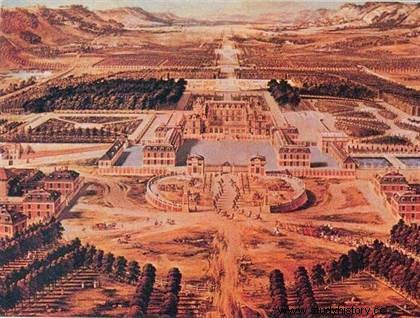 In July 1668, "The Great Royal Entertainment of Versailles will be the second party given. It was during these parties that the courtiers measured the discomfort of the small castle, many could not find a place to sleep. Le Vau then proposed 2 projects for the expansion of the castle:the first provided for the destruction of the primitive castle and the second which was retained:enlargement on the garden side, by a stone envelope, the construction of which was carried out between 1668 and 1670:it is makes it a second building encircling the first castle. On each side of the old castle were built the Grand Apartment of the King to the north, that of the Queen to the south. Between the two, a large terrace was installed facing the gardens. The facades were decorated with Rance marble columns, gilded wrought iron balconies, busts placed on the balustrades. The courtyard was paved with marble. The Commons were raised, received a peristyle of columns surmounted by statues and connected to the Louis XIII castle by a series of pavilions, the Royal Court was closed by a golden gate. The area of the estate thus tripled .
In July 1668, "The Great Royal Entertainment of Versailles will be the second party given. It was during these parties that the courtiers measured the discomfort of the small castle, many could not find a place to sleep. Le Vau then proposed 2 projects for the expansion of the castle:the first provided for the destruction of the primitive castle and the second which was retained:enlargement on the garden side, by a stone envelope, the construction of which was carried out between 1668 and 1670:it is makes it a second building encircling the first castle. On each side of the old castle were built the Grand Apartment of the King to the north, that of the Queen to the south. Between the two, a large terrace was installed facing the gardens. The facades were decorated with Rance marble columns, gilded wrought iron balconies, busts placed on the balustrades. The courtyard was paved with marble. The Commons were raised, received a peristyle of columns surmounted by statues and connected to the Louis XIII castle by a series of pavilions, the Royal Court was closed by a golden gate. The area of the estate thus tripled .
To do all this new work on the Envelope, let's quote a passage from Colbert's report:"we have 566 workers working here, the masonry expenses are the following:335,000 pounds in 1669, 586,000 in 1670, 428,500 in 1671 the year the shell was completed ". In October 1670, François d'Orbay continued the work of Le Vau who had just died. Louis XIV had managed to keep his father's castle intact on the city side, but on the garden side, it disappeared, hidden by new buildings. Henceforth, a distinction was made between the Château Vieux:that of Louis XIII and the Château Neuf:that of Louis XIV.
The Château Neuf was of Italian design:all in stone, the long facades punctuated by avant-corps, a large terrace was installed between the 2 royal apartments. In order to access the Grand Apartment, a majestic access was needed:the King's Grand Degré or the Ambassadors' Staircase. It took six years and considerable sums to create the most sumptuous entrance to the château. This staircase was only used for 70 years, it was destroyed during the reign of Louis XV in 1752.
Despite the basic Italian design, the French spirit dominated by the existence of arched windows on the ground floor, the floor is provided with Ionic columns, niches , high rectangular windows (curved by Mansart in 1669), statues are placed in the niches, appearance of bas-relief surmounting the windows, the second floor had a Corinthian style decoration, and was surmounted by a balustrade where rested trophies.
In 1670 the Porcelain Trianon was built. At the same time, courtiers began to build their residences near the castle:in 2 years, 14 large hotels were built in the city of Versailles (including the hotels of Luxembourg, Noailles, Guise, Bouillon, Gesvres). Louis XIV had realized his dream:to build a palace that would mark his time. The king wanted to bring the ministers and their departments together with him. He thus wished to establish his residence at Versailles. Mansart had to draw up plans for the installation of the Court. Versailles was seen as a symbol of centralism.
Between 1678 and 1684, on the former terrace of the new château, the Hall of Mirrors was created. Louis XIV had appreciated the long galleries of the Tuileries, the Louvre or Fontainebleau which are places of passage, means of communication between apartments. The decoration was entrusted to Le Brun. Limited to the north by the Salon de la Guerre and to the south by the Salon de la Paix, the Gallery is 73m long and will have a major consequence:the king's apartment will be deported to the Château Vieux, the Sun apartment will become the Large Apartment and will be used for receptions.
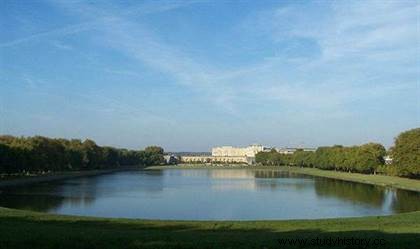 In 1678, the first stones of the wing of the South intended to house the courtiers were laid. In the Cabinet des Bains, elongated white marble tanks are added, we are witnessing the start of work on the Swiss pond and the Neptune basin as well as the excavation of the Parterre du Midi and the new Orangery.
In 1678, the first stones of the wing of the South intended to house the courtiers were laid. In the Cabinet des Bains, elongated white marble tanks are added, we are witnessing the start of work on the Swiss pond and the Neptune basin as well as the excavation of the Parterre du Midi and the new Orangery.
In 1679, the Hall of Mirrors, the Salon de la Guerre and the Salon de la Paix replaced the terrace and the cabinets of the king and queen. The central building, on the Marble Court side, is topped by a floor. A clock is placed there. A second staircase was created:the Queen's staircase, matching the Ambassadors' staircase. Only the two doors still exist in the Grand Apartment, the bust of Louis XIV. After the completion of the Ministers' wings, the construction of the Grandes and Petites Ecuries began.
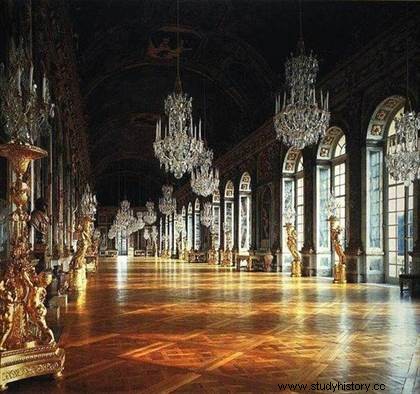 In 1681, the decoration of the Grand Apartments was completed. The Machine de Marly begins to pump water from the Seine. We proceed to the excavation of the Grand Canal and the Swiss pond and we note the multiplication of groves and fountains in the gardens:this is how the French Gardens were born, decorated with marble statues and bronze.
In 1681, the decoration of the Grand Apartments was completed. The Machine de Marly begins to pump water from the Seine. We proceed to the excavation of the Grand Canal and the Swiss pond and we note the multiplication of groves and fountains in the gardens:this is how the French Gardens were born, decorated with marble statues and bronze.
Louis XIV moves to Versailles
On May 6, 1682, Louis XIV could not wait any longer:he left Saint Cloud and settled permanently in Versailles, which became the Official Residence of the King of France. Here is the description of the installation, told by a contemporary:"on the sixth of May the King left Saint Cloud to come and settle in Versailles, where he had wanted to be for a long time, although it was full of masons, in the plan to stay there until after the confinement of Madame La Dauphine, who was obliged to change apartments the second day she arrived, because the noise prevented her from sleeping ". The King settled in a house under construction, the Hall of Mirrors was cluttered with scaffolding, to cross it you had to pass over beams. Louis XIV was 44 years old. It breaks with the itinerant tradition of the kings of France who went from castle to castle.
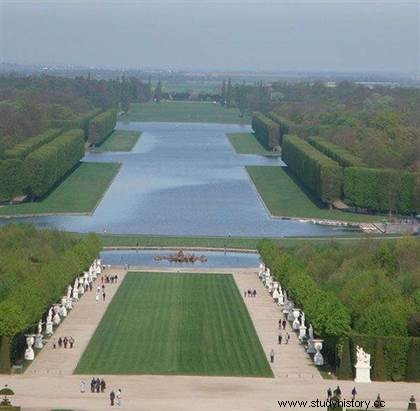 In 1683, in an apartment forbidden to any unauthorized person, the architects fitted out salons and cabinets intended for the chiefs of works and collections of the king. In the Cabinet aux Tableaux, the Cabinet aux Coquilles, the Cabinet des Médailles (lit by rock crystal chandeliers), all sorts of rich curiosities were exhibited, the walls bore paintings from the royal collections. Among the "curiosities" were vases garnished with gold and diamonds, antique busts and figures, a large gold nave garnished with diamonds and rubies, porcelain from China and Japan, vases from agate, emerald, turquoise, jade, jasper, starstone, a large quantity of pearl conch vases, statues of ancient animals, a large jasper vase which was used for the baptism of Charles V .
In 1683, in an apartment forbidden to any unauthorized person, the architects fitted out salons and cabinets intended for the chiefs of works and collections of the king. In the Cabinet aux Tableaux, the Cabinet aux Coquilles, the Cabinet des Médailles (lit by rock crystal chandeliers), all sorts of rich curiosities were exhibited, the walls bore paintings from the royal collections. Among the "curiosities" were vases garnished with gold and diamonds, antique busts and figures, a large gold nave garnished with diamonds and rubies, porcelain from China and Japan, vases from agate, emerald, turquoise, jade, jasper, starstone, a large quantity of pearl conch vases, statues of ancient animals, a large jasper vase which was used for the baptism of Charles V .
In 1684, the Collectors' apartment was enlarged by annexing the former Montespan apartment, transformed into a small gallery, the ceiling of which was painted by Mignard, on the theme d'Apollon et de Minerve, the floor was made of precious wood parquet, the walls hung with sumptuous fabrics. In this room, Louis XIV exhibited important pieces from his collection of paintings, including the Mona Lisa .
The construction of ancillary buildings
Between 1685 and 1689, several buildings were built:at the Orangery which replaced that of Le Vau by providing 3,000 shrubs and 150,000 plants each year, at the stables, at the Grand Commun , to the north wing of the courtiers. In 1686, Le Brun finished decorating the Hall of Mirrors. In 1687, Louis XIV erected a small palace of marble and porphyry with gardens, on the site of the porcelain Trianon:this will be the Grand Trianon.
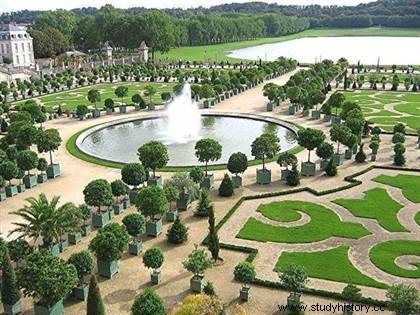 The construction of the North and South wings extended the development of the facades. These two new buildings housed the Princes and courtiers, stables, carriages, general services and servants. The facade at that time had a length of 670 m.
The construction of the North and South wings extended the development of the facades. These two new buildings housed the Princes and courtiers, stables, carriages, general services and servants. The facade at that time had a length of 670 m.
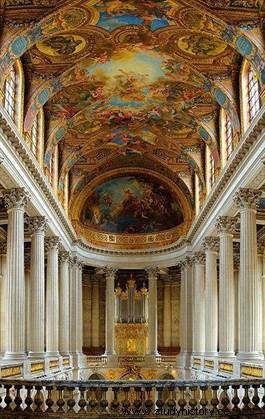 The construction of the Royal Chapel, dedicated to Saint Louis, began in 1689, interrupted by the war, resumed in 1699 by Mansart, and was completed in 1710. The architecture is based on palatine architecture, with two floors:one reserved for the King, the other downstairs at the Court:the king attended mass from the top of the tribune and the Court, with their backs to the altar, their faces raised, gazed at their monarch. The style is Corinthian with columns. Bernini will leave his Italian influence there. There is not the splendor of the multicolored marbles of the King's Apartments, it is bare stone, the floor bears the design of the royal arms in the center of the nave and the figure of the King "L" entwined, crowned in front of the steps from the altar. The vault is painted and represents an iconography which opposes the Old and the New Testament. The organ is placed above the altar.
The construction of the Royal Chapel, dedicated to Saint Louis, began in 1689, interrupted by the war, resumed in 1699 by Mansart, and was completed in 1710. The architecture is based on palatine architecture, with two floors:one reserved for the King, the other downstairs at the Court:the king attended mass from the top of the tribune and the Court, with their backs to the altar, their faces raised, gazed at their monarch. The style is Corinthian with columns. Bernini will leave his Italian influence there. There is not the splendor of the multicolored marbles of the King's Apartments, it is bare stone, the floor bears the design of the royal arms in the center of the nave and the figure of the King "L" entwined, crowned in front of the steps from the altar. The vault is painted and represents an iconography which opposes the Old and the New Testament. The organ is placed above the altar.
The Upper Vestibule of the Chapel occupies the site of the first grotto of Thetis, built in 1665 and destroyed in 1685. It extends the decor of the Chapel, white stone, columns and pilasters surmounted by Corinthian capitals, ceiling decorated with stucco medallions representing the four parts of the world, doors and windows surmounted by arcades sculpted with figures of the Virtues. This vestibule formed the junction between the Grands Appartements and the Chapel and allowed passage to the apartments of the North Wing as far as the theatre.
Interior fittings
In 1689, access to the Queen's apartments was via the Queen's staircase, on the landing 2 rooms of the Bodyguards, then the Antechamber, the Grand Cabinet and the Chamber which opened into the Salon de la Paix. This enfilade was on the south facade of Le Vau's envelope. The new apartments of the king developed around the Cour de Marbre. They consisted of 7 pieces. In the center of the castle was installed the King's salon (future bedroom of Louis XIV), the apartment ended with the cabinet of the Council and the cabinet of Termes or Wigs. During this period, 22,000 to 36,000 workers and 6,000 horses were busy on the various sites.
Louvois, Superintendent of Buildings, pressed contractors, workers, artists, and threatened the less zealous with prison. The ransom of harsh working conditions, accidents injured, crippled, killed. The following compensation was provided:30 to 40 pounds for a broken arm or leg, 60 pounds for a gouged eye, 60 to 100 pounds for the widow.
Strike movements, which were called seditions, sometimes agitated the site. In order to reduce these actions, Louvois specified the wages paid to the stonemasons:“for each toise of stone from Saint Cloud, 2 feet high, polished:they were paid 50 sols; for those from 20 to 21 inches:45 sols ". During this same period, an entire forest was planted. Jules Hardouin Mansart was responsible for this major project. The bill amounted in those days to 80 million pounds.
The village of Versailles was transformed into a real city, built in the axis of the castle. The courtiers housed in the castle erected hotels to house their servants, taverns contributed to the animation of the city, the inhabitants of the city of Versailles will reach the number of 70,000 on the eve of the revolution.
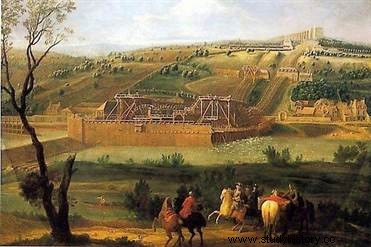 In 1701, the king's bedroom was placed in the center of the castle. The 1689 bedroom and the Bassan antechamber are combined to form the Bull's eye bedroom.
In 1701, the king's bedroom was placed in the center of the castle. The 1689 bedroom and the Bassan antechamber are combined to form the Bull's eye bedroom.
Remark of Saint Simon:"we would not end up on the monstrous defects of a palace so immense, and so immensely expensive, with its accompaniments which are even more so :orangery, vegetable gardens, kennels, large and small stables alike, prodigious outbuildings; finally an entire city... Again this Versailles of Louis XIV, this masterpiece so ruinous and in such bad taste... could it not be completed . »
The gardens of Versailles
In 1662, after Fouquet's disgrace, Louis XIV focused on Versailles. He will use the team that created Vaux le Vicomte:Le Vau, Le Brun and Le Nôtre to begin a program of embellishment and expansion of Versailles. From this date, the enlargements of the castle also applied to the gardens. Groves and parterres were enlarged and new ones created. At that time, the Orangery and the Grotto of Thetis were built. The Orangery is the masterpiece of Le Vau, located south of the castle taking advantage of the slope of the hill. There were stored the orange trees in winter. The first orange trees and small shrubs were those confiscated at Vaux le Vicomte.
The Grotto of Thetis, to the north of the castle, was a symbolic part of the castle and gardens that aligned the Sun King with the solar metaphor. The grotto was completed in 1670. It alluded to the myth of Apollo. The interior is decorated with shell motifs, with statues representing the sun god cared for by Nereids. The grotto played a crucial role in the hydraulic system that provided water to the gardens:the roof supported a reservoir that held water pumped from the Clagny pond to supply the fountains in the musical gardens.
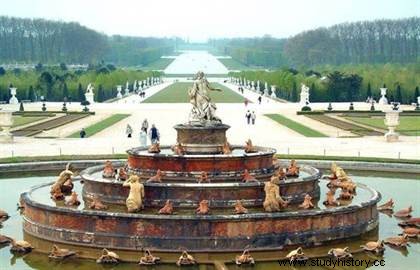 In 1664, the gardens were inaugurated during the fête galante:the pleasures of the Enchanted Island, officially in honor of Anne of Austria and Marie Thérèse of Austria, but in reality in honor of Louise de La Vallière. From 1665 to 1668, there was a revival of activity in the gardens, with the installation of fountains and new groves, with symbolism devoted to solar and Apollonian themes. The first topographical networks were created, with the completion of the Latona basin and the Apollonian basin, the Labyrinth, south of the Latona parterre and near the Orangery, consisting of a simple network of paths, the Latona basin, on the east-west axis, designed by Le Nôtre, represented an episode taken from Ovid's Metamorphoses, in reference to the revolutions of the Fronde that Louis XIV kept in memory. Let us quote a passage from La Fontaine:
In 1664, the gardens were inaugurated during the fête galante:the pleasures of the Enchanted Island, officially in honor of Anne of Austria and Marie Thérèse of Austria, but in reality in honor of Louise de La Vallière. From 1665 to 1668, there was a revival of activity in the gardens, with the installation of fountains and new groves, with symbolism devoted to solar and Apollonian themes. The first topographical networks were created, with the completion of the Latona basin and the Apollonian basin, the Labyrinth, south of the Latona parterre and near the Orangery, consisting of a simple network of paths, the Latona basin, on the east-west axis, designed by Le Nôtre, represented an episode taken from Ovid's Metamorphoses, in reference to the revolutions of the Fronde that Louis XIV kept in memory. Let us quote a passage from La Fontaine:
Latona and her Gemini
Rough, rude people make vile animals,
Change them with the water they pour on them…
The stage is a pool of vast expanse;
On the edges, this brood, become insect,
Task to throw water against the deities.
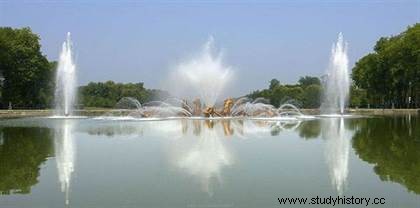
The Bassin d'Apollon, on the same axis, occupies the former location of the Bassin des Cygnes in the time of Louis XIII. It formed a focal point in the gardens and served as a transition between the gardens and the Grand Canal. This Grand Canal which was built between 1668 and 1671 with the dimensions of 1,500 m long and 62 m wide, 23 hectares in area , extends the east-west axis. Under the Ancien Régime, it was used for boat entertainment. A Little Venice was installed to house the caravels and yachts received from the Netherlands, the gondolas received by the Doge of Venice. The Grand Canal received the water that flowed from the fountains in the gardens upstream. This water was pumped by windmills and horse mills, then sent back to the tank placed on the cave of Thetis in order to supply the fountains. This system operated in a closed circuit.
Flowers were brought back from exotic countries:jasmine from Spain, hyacinths and narcissus from Constantinople, the most fragrant flowers were needed.
From 1672 to 1677, the Labyrinth was redesigned to serve for the education of the dolphin, new fountains were installed representing the fables of Aesop, plaques were engraved:it this is how the son of Louis XIV learned to read. In the end, the Labyrinth included 39 fountains with 333 lead animal sculptures.
Above the Latona fountain, was the terrace of the castle, known as the Parterre d'Eau, a place where the symbolism of the large apartments was synthesized with that of the gardens.
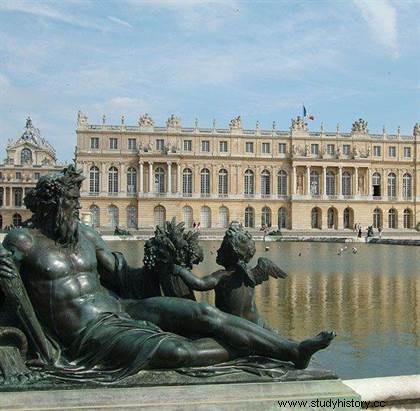 The Musical Water Parterre was decorated with 24 statues representing the 4 elements:earth, air, water, fire; the 4 seasons:spring, summer, autumn, winter; the 4 parts of the world:Europe, Africa, Asia, America; the 4 poems:pastoral, satirical, heroic, lyrical; the 4 hours of the day:dawn, noon, evening, night; the 4 abductions:Boreas abducting Orithya, Saturn abducting Cybele, Pluto abducting Proserpina, Neptune abducting Coronis.
The Musical Water Parterre was decorated with 24 statues representing the 4 elements:earth, air, water, fire; the 4 seasons:spring, summer, autumn, winter; the 4 parts of the world:Europe, Africa, Asia, America; the 4 poems:pastoral, satirical, heroic, lyrical; the 4 hours of the day:dawn, noon, evening, night; the 4 abductions:Boreas abducting Orithya, Saturn abducting Cybele, Pluto abducting Proserpina, Neptune abducting Coronis.
In 1676, the Bassin des Sapins to the north of the castle, was designed on the north-south axis, and in 1678 the Piece d'Eau des Suisses, in a marshy region south of the castle, with an area of 15 hectares , the largest after the Grand Canal.
The Groves
To enlarge the gardens, Le Nôtre added or enlarged 10 groves:in 1670:Marais grove, rectangular pond, metal reed on the edges, swan at each corner, a tree iron in the center; 1671:Water Theater grove, King's Island and Water Mirror, Trois-Fontaines grove; 1672 :bosquet de l’Arc de Triomphe remanié en 1676 avec un décor rappelant les victoires militaires; 1675 :bosquet de la Renommée ou des Dômes, bosquet de l’Encelade (un Titan condamné à vivre sous l’Etna); 1678 :bosquet des Sources; 1680 :nouveau bosquet :la Galerie des Antiques :galerie à ciel ouvert, avec des statues antiques, 20 statues sur socles, chacune séparée par 3 jets d’eau; 1681 – 1683 :la Salle de Bal :construite dans une partie isolée des jardins, avec cascade; et enfin 1684 – 1685 :la Colonnade fut installée sur l’ancien Bosquet des Sources :péristyle de 32 arcs avec 28 fontaines, statue actuelle Enlèvement de Proserpine.
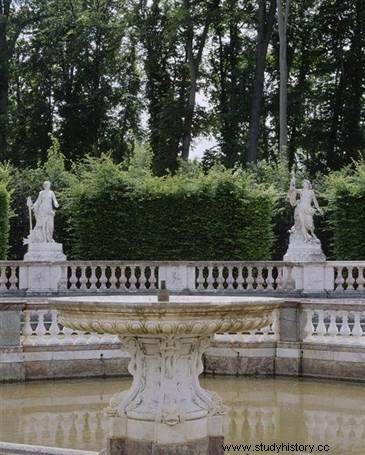 Louis XIV demanda également de nouveaux aménagements concernant les bosquets :1680 :Tapis Vert :pelouse entre le bassin de Latone et le bassin d’Apollon; 1684 :le Parterre d’Eau est remanié, avec des statues de bronze représentant les fleuves de France; 1684 :l’Orangerie de Le Vau est détruite remplacée par la configuration actuelle :Orangerie, Escalier de Cent Marches et Pièce d’Eau des Suisses, Parterre du Midi; 1685 – 1686 :le Parterre du Nord est remanié, de nouveaux réservoirs plus grands sont installés vers le nord de l’Aile des Nobles; entre 1704 et 1709 :des bosquets furent remaniés, renommés, suggérant l’austérité qui marqua les dernières années du règne de Louis XIV, tel le bosquet du Marais, du Théâtre d’Eau remanié en l’Ile aux Enfants.
Louis XIV demanda également de nouveaux aménagements concernant les bosquets :1680 :Tapis Vert :pelouse entre le bassin de Latone et le bassin d’Apollon; 1684 :le Parterre d’Eau est remanié, avec des statues de bronze représentant les fleuves de France; 1684 :l’Orangerie de Le Vau est détruite remplacée par la configuration actuelle :Orangerie, Escalier de Cent Marches et Pièce d’Eau des Suisses, Parterre du Midi; 1685 – 1686 :le Parterre du Nord est remanié, de nouveaux réservoirs plus grands sont installés vers le nord de l’Aile des Nobles; entre 1704 et 1709 :des bosquets furent remaniés, renommés, suggérant l’austérité qui marqua les dernières années du règne de Louis XIV, tel le bosquet du Marais, du Théâtre d’Eau remanié en l’Ile aux Enfants.
Histoire du Chateau de Versailles après la mort de Louis XIV
En 1715, à la mort de Louis XIV, le nouveau roi n’est qu’un enfant, son tuteur Philippe d’Orléans quitte Versailles le 9 septembre pour s’installer dans sa résidence du Palais Royal. Pendant cette régence, le duc de Noailles proposa de raser le château ! Mais bien heureusement, il n’eut pas d’appuis suffisants…
En 1717, Pierre le Grand, tsar de Russie, visite Versailles et réside au Grand Trianon.
Quelques années plus tard, en 1722, Louis XV, 22 ans, se réinstalle à Versailles dans les appartements de Louis XIV. Il est soucieux de faire respecter les traditions de l’époque, mais le château ne retrouva plus le lustre des années Louis XIV. Louis XV n’affectionnant pas particulièrement Versailles, lorsqu’il y était, il se réfugiait dans les Petits Appartements, ou au Trianon, à Marly, Compiègne ou Fontainebleau.
Il fit quand même quelques transformations :démolition de l’appartement des Bains et l’escalier des Ambassadeurs; construction du salon d’Hercule, de l’opéra et du Petit Trianon; transformation des appartements du Roi, de la Reine et des princes, afin que cela soit plus conforme aux goûts de l’époque et plus confortables, (travaux faits par Gabriel); décoration de la grande salle ou salon d’Hercule, avec les parois recouvertes de marbres choisis par Louis XIV, la nouveauté résidait dans le plafond compartimenté d’aucun cadre sculpté. Le salon d’Hercule reliait les appartements du Roi au vestibule de la chapelle.
En 1729, début des travaux de renouvellement du décor de la chambre de la Reine, qui se termineront en 1735. Le salon d’Hercule fut en travaux de 1729 à 1736. Il se trouve à l’emplacement de l’ancienne chapelle. La décoration du plafond représente l’Apothéose d’Hercule, le mur du fond décoré par une immense toile de Véronèse offerte à Louis XIV en 1664. L’inauguration eut lieu en 1739 lors d’un bal donné à l’occasion de la fille aînée de Louis XV. Ce salon servit aux grandes occasions :mariage du duc de Chartres en 1769, naissance du Dauphin en 1782.
De 1738 à 1760, l’appartement des Collectionneurs de Louis XIV furent constamment remanié. Puis le Bassin de Neptune fut achevé en 1741. En 1750, Louis XV introduisit un nouveau type de pièces :la salle à manger des retours de chasse, et la même année dans le secteur qu’occupe actuellement le Hameau de la Reine, Louis XV fit construire et entretenir des jardins botaniques.
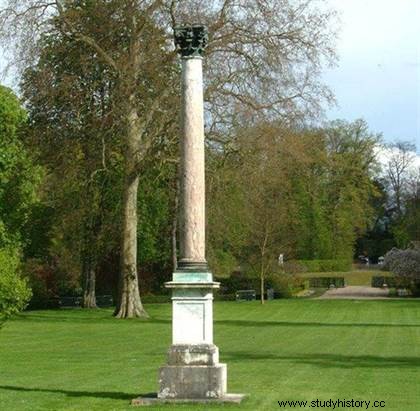 En 1752, le roi fait procéder à la destruction de l’escalier des Ambassadeurs, de la Petite Galerie et du cabinet des Médailles. Ces deux « témoins » de Louis XIV furent détruits pour la création de l’appartement destiné à l’ainée des Filles de France :Madame Adélaïde. Louis XV entama ensuite en 1755 la seconde transformation des lieux :l’ancien Cabinet du Roi ou du Conseil et le Cabinet des Thermes ou des Perruques furent réunis pour créer le Grand Salon du Conseil. Au second étage, se développaient les cabinets intérieurs du roi. Dans cette partie du château, aucune dorure ne colorait les boiseries. Des couleurs vives et variées égayaient les statues. L’élément essentiel de cet appartement était une petite galerie éclairée sur la cour de marbre.
En 1752, le roi fait procéder à la destruction de l’escalier des Ambassadeurs, de la Petite Galerie et du cabinet des Médailles. Ces deux « témoins » de Louis XIV furent détruits pour la création de l’appartement destiné à l’ainée des Filles de France :Madame Adélaïde. Louis XV entama ensuite en 1755 la seconde transformation des lieux :l’ancien Cabinet du Roi ou du Conseil et le Cabinet des Thermes ou des Perruques furent réunis pour créer le Grand Salon du Conseil. Au second étage, se développaient les cabinets intérieurs du roi. Dans cette partie du château, aucune dorure ne colorait les boiseries. Des couleurs vives et variées égayaient les statues. L’élément essentiel de cet appartement était une petite galerie éclairée sur la cour de marbre.
De 1758 à 1770, il y eut la construction de l’Opéra Royal, à l’extrémité de l’Aile Nord du château. La première salle de spectacle crée fut rapidement trop petite, Madame de Pompadour faisant partie d’une troupe de comédiens, les petits théâtres étaient insuffisant pour les spectateurs. L’Opéra Royal fut donc inauguré lors du mariage de son petit fils avec l’archiduchesse Marie Antoinette en mai 1770.
Gabriel effectua de multiples travaux afin de loger toutes les princesses, car au fil des années toutes ces dames changeaient d’appartements, passant de l’Aile du Midi à l’Aile du Nord, au rez-de-chaussée du Corps central, ainsi l’Appartement des Bains, l’Escalier des Ambassadeurs et le cloisonnement de la Galerie Basse ont disparu. Louis Philippe détruira ces appartements, mais quelques boiseries restent et témoignent du luxe de l’époque.
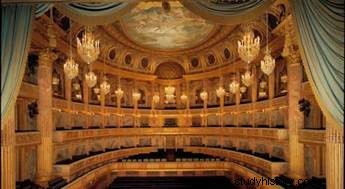 Selon la tradition instaurée par Louis XIV, le dauphin et son épouse entrent en possession des 2 appartements du rez-de-chaussée, situés sous l’appartement de la Reine et sous une partie de la Galerie des Glaces. Au 19è siècle, tout fut ravagé, seules la chambre du dauphin et la bibliothèque furent conservées.
Selon la tradition instaurée par Louis XIV, le dauphin et son épouse entrent en possession des 2 appartements du rez-de-chaussée, situés sous l’appartement de la Reine et sous une partie de la Galerie des Glaces. Au 19è siècle, tout fut ravagé, seules la chambre du dauphin et la bibliothèque furent conservées.
De 1761 à 1769, le petit Trianon est construit par Gabriel; la même année la princesse Adélaïde déménage et son appartement est réuni à celui de Louis XV, les deux pièces principales formant la Chambre du Roi.
En 1772, Gabriel débuta les travaux de son « Grand Projet » :reconstruction des façades côté ville, les travaux ne furent jamais achevés, seule l’Aile Louis XV fut terminée. A l’intérieur, les travaux sur le « Grand Degré » seront achevés en 1785.
A la fin de l’ancien Régime, le palais sera la résidence royale la plus luxueuse de toute l’Europe.
Sous Louis XVI, la vie à Versailles déclinait de jours en jours, la famille royale et les courtisans fuyaient. Le château se révéla être un gouffre financier. Une rénovation profonde des bâtiments devenait urgente en raison de l’absence de commodités :salle de bains, chauffage dans les appartements. Le projet fut ajourné jusqu’à la Révolution. Marie Antoinette imposa d’importantes dépenses pour l’aménagement du Petit Trianon. Les grandes fêtes à Versailles n’eurent plus lieu, sauf celle de l’Assomption le 15 août où tous les courtisans devaient être présents; c’est au cours de la cérémonie de 1785, que le roi fit arrêter le Cardinal de Rohan, compromis dans l’affaire du Collier de la Reine.
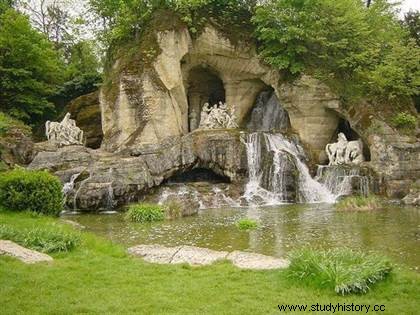 En 1774 et 1775, inspiré par les Philosophes, Louis XVI fit replanter totalement les jardins, des arbres et arbustes datant de Louis XIV furent abattus pour transformer les jardins français de Le Nôtre en jardins à l’Anglaise. Mais la topologie du domaine ne favorisait pas les jardins à l’Anglaise :ces jardins sont caractérisés par des formes irrégulières. Les jardins furent donc replantés à la Française. Louis XVI fit supprimer les palissades formant des murs pour les remplacer par des tilleuls ou des marronniers. Il fit construire la grotte des Bains d’Apollon, grotte en rocaille.
En 1774 et 1775, inspiré par les Philosophes, Louis XVI fit replanter totalement les jardins, des arbres et arbustes datant de Louis XIV furent abattus pour transformer les jardins français de Le Nôtre en jardins à l’Anglaise. Mais la topologie du domaine ne favorisait pas les jardins à l’Anglaise :ces jardins sont caractérisés par des formes irrégulières. Les jardins furent donc replantés à la Française. Louis XVI fit supprimer les palissades formant des murs pour les remplacer par des tilleuls ou des marronniers. Il fit construire la grotte des Bains d’Apollon, grotte en rocaille.
En 1778, Louis XVI ordonna la destruction du Labyrinthe de Louis XIV. A la place, fut crée un arboretum avec des exemplaires exotiques. Ce sera dans cette partie de jardin qu’aura lieu l’épisode du Collier de la Reine, compromettant Marie Antoinette.
Lors de son avènement, Louis XVI fit construire et aménagée une pièce pour lui :la Bibliothèque. La décoration est confiée à Gabriel, les sculptures à Rousseau, deux globes terrestre et céleste complètent le décor en 1777. C’est dans cette bibliothèque que Louis XVI décide l’arrestation du grand aumônier, après avoir été conseillé par le baron de Breteuil et le Garde des Sceaux Miromesnil. En 1783, le Cabinet doré reprend sa première destination :Louis XIV y abritait ses collections, Louis XV y exposait sa vaisselle en or, mais Madame Adélaïde rattacha cette pièce à ses appartements et en fit son cabinet de Musique. Louis XVI y exposa à nouveau ses collections, ce cabinet deviendra le Cabinet des Papillons.
Versailles a vu l’apogée des Bourbons, mais aussi la chute :les Etats Généraux de 1789 se tinrent à Versailles.
Versailles dans le tumulte de la Révolution
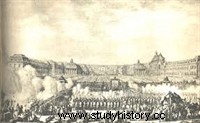 En octobre 1789, le peuple de Paris, conduit par les femmes, marche sur Versailles, les grilles du château sont fermées, une fusillade éclate, le peuple pénètre malgré tout dans le château et ramène la famille royale à Paris. Le château ne retrouvera jamais ses fastes. La ville de Versailles se dépeuple :de 51 000 habitants, elle passera à 39 000 en 1791. Le mobilier du château est transporté dans des gardes meubles. Le magnifique bureau de Louis XV sera affecté au Ministère de la Marine.
En octobre 1789, le peuple de Paris, conduit par les femmes, marche sur Versailles, les grilles du château sont fermées, une fusillade éclate, le peuple pénètre malgré tout dans le château et ramène la famille royale à Paris. Le château ne retrouvera jamais ses fastes. La ville de Versailles se dépeuple :de 51 000 habitants, elle passera à 39 000 en 1791. Le mobilier du château est transporté dans des gardes meubles. Le magnifique bureau de Louis XV sera affecté au Ministère de la Marine.
Début 1791, les tableaux, les glaces et les emblèmes royaux sont décrochés des murs, les œuvres d’art envoyées au Louvre, devenu Musée Central des Arts en 1792 :« Versailles fut déroyalisé », la bâtisse échappa à une vulgaire démolition. Les livres et les médailles allèrent à la Bibliothèque municipale de la ville de Versailles.
Puis en 1792, sur ordre de la Convention, certains arbres furent abattus, certaines parties du Grand Parc vendues. Le Directeur des Jardins Botaniques fit pression sur le gouvernement révolutionnaire afin de sauvegarder les jardins. Il y réussit à condition que les parterres puissent être plantés de potagers et les vergers transformés en espaces publics. Ces plans ne virent jamais le jour, mais les jardins furent ouverts à tous, il n’était pas rare de voir des gens occupés à faire leur lessive dans les fontaines et étaler le linge sur les arbustes. La résidence royale fut transformée en cité des arts :l’appartement de Mesdames, au rez-de-chaussée de l’aile nord se transforma en Musée d’histoire Naturelle, l’aile des Ministres accueillit l’Ecole Centrale de Seine et Oise, le salon d’Hercule fut transformé en école du modèle vivant, future école des Beaux Arts, la salle de l’Opéra en conservatoire de musique.
En 1793, la Convention vend à l’encan le mobilier du château :17 180 lots étalés sur les années 1793 à 1796, les plus belles pièces partent en Angleterre, meublant le Palais de Buckingham ou le Château de Windsor.
Napoléon songea un temps à transformer le château et en faire son palais impérial. Il disait :« ce qui est grand est beau », il estimait pourtant Versailles trop petit, il ne s’y sent pas à l’aise. Il déclara un jour à l’architecte Fontaine :« pourquoi la Révolution qui a tant détruit, n’a-t-elle pas démoli le Château de Versailles ! je n’aurais pas aujourd’hui un tort de Louis XIV sur les bras, un vieux château mal fait, un favori sans mérite à rendre supportable ". Il refusa Versailles en tant que Palais Impérial, et évita les dépenses supplémentaires, en ne faisant que les restaurations nécessaires. Trianon le séduisait davantage, il y fit quelques travaux et le remeubla dès 1805. Mais il procéda à l’abattage catastrophique des arbres du bosquet de l’Arc de Triomphe et celui des Trois-Fontaines. Suite à l’érosion de la terre, il a fallu replanter de nouveaux arbres.
En 1815, Philippe Antoine de Noailles, prince de Poix devient gouverneur de la Maison Royale de Versailles et de Trianon.
Louis XVIII songea à réinvestir Versailles. Mais devant l’aspect financier et moral (un retour de la royauté à Versailles serait considéré comme une provocation) il abandonna ce projet. En 1817, il marqua « son passage » en ordonnant la transformation des deux bosquets :celui de l’ile du Roi et le Miroir d’eau en jardin à l’Anglaise pour former le Jardin du Roi.
Versailles depuis le XIXe siècle
Ce n’est que grâce à Louis Philippe I er , roi des Français, que Versailles sera définitivement sauver de la ruine et de toutes autres menaces possibles. Il décide donc de l’offrir aux français. En 1833, il décrète la transformation du château en musée en confiant cette tâche à son ministre le comte de Montalivet. Le musée célèbrera les conquêtes militaires depuis Clovis à l’Ancien Régime, de la Révolution Française à l’Empire et à la Restauration. Les travaux de restauration seront payés sur la cassette personnelle du roi et s’élèveront à plus de 23 millions de Francs. Il fit également restaurer le Grand Trianon pour son usage personnel. La Galerie des Batailles a été spécialement conçue pour Louis Philippe :120 m de long sur 13 m de large, dans l’Aile du Midi, ornée de 32 tableaux célébrant les batailles militaires glorieuses, de la Bataille de Tolbiac à celle de Wagram.
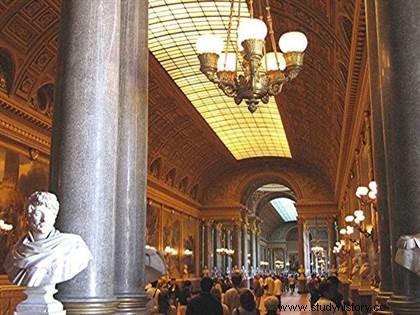 L’inauguration du Musée dont la dédicace est :« à toutes les gloires de la France » a lieu en juin 1837. Ce sera la principale source de l’histoire de France avec plus de 6 000 peintures et 3 000 sculptures. Le roi des français avait érigé l’unité de la nation en programme politique. L’Histoire était convoquée pour en faire la constante démonstration.
L’inauguration du Musée dont la dédicace est :« à toutes les gloires de la France » a lieu en juin 1837. Ce sera la principale source de l’histoire de France avec plus de 6 000 peintures et 3 000 sculptures. Le roi des français avait érigé l’unité de la nation en programme politique. L’Histoire était convoquée pour en faire la constante démonstration.
Lors de l’inauguration, un banquet de 1 500 couverts fut préparé dans la galerie des Glaces et les salons des grands appartements, puis fut joué le Misanthrope, enfin une promenade aux flambeaux divertit les visiteurs jusqu’à 2 heures du matin.
Citons les mots de Victor Hugo à cette occasion :« ce que le roi Louis Philippe a fait à Versailles est bien. Avoir accompli cette œuvre, c’est avoir été grand comme roi et impartial comme philosophe, c’est avoir fait un monument national d’un monument monarchique, c’est avoir mis une idée immense dans un immense édifice, c’est avoir installé le présent dans le passé, 1789 vis – vis de 1688, l’empereur chez le roi, napoléon chez Louis XIV, en un mot c’est avoir donné à ce livre magnifique qu’on appelle l’histoire de France cette magnifique reliure qu’on appelle Versailles .
En 1860, une bonne partie des vieux arbres de l’époque de Louis XVI fut abattue et remplacée. La replantation ne commença qu’en 1883 pour cause de guerre franco-allemande et chute du Second Empire.
Napoléon III fit quelques travaux, mais se garda de reprendre les projets extravagants de son oncle. Lors de l’exposition Universelle de 1867, des meubles prestigieux furent réintégrés dans le Patrimoine du château, grâce à l’impératrice Eugénie qui vouait un culte à Marie Antoinette.
Pendant la guerre de 1870, lors du siège de Paris, le château devient le quartier général de l’armée prussienne. L’empire Allemand fut proclamé dans la Galerie des Glaces en janvier 1871. Durant la Commune, Thiers et son gouvernement s’y réfugièrent et y restèrent jusqu’en 1879. Versailles retrouvait son rôle de place de gouvernement, la population qui était de 40 000 habitants passa à 150 000.
Le château servit également pour l’élection des présidents de la IIIe et de la IVe République. Le traité de paix, dit Traité de Versailles mettant fin à la Première Guerre Mondiale y fut signé en juin 1919.
De nos jours, Versailles est un palais national à la disposition de la Présidence de la République, accueillant les chefs d’Etats Étrangers, lieu de réunion du Congrès du Parlement.
Quelle est la superficie du Château de Versailles ?
La superficie du Château de Versailles est d'environ 63 154 m² , à laquelle il faut ajouter les 815 ha du parc attenant, ce qui en fait le plus grand château du monde devant celui de Windsor. De nombreux monuments et bâtiments s'y trouvent, comme par exemple le Petit et le Grand Trianon, mais également l'immense jardin créé par Le Nôtre ainsi que le Grand Canal et la pièce d'eau des Suisses.
Quel est le nombre de chambres au Château de Versailles ?
Le château contient 2300 pièces. L'on y trouve également 67 escaliers, 352 cheminées, 2153 fenêtres, plus d'une centaine de pendules, et la fameuse galerie des Glaces est composée de 357 miroirs !
Sources
- Histoire de Versailles de Jean François Solnon. Tempus, 2003.
- C’était Versailles d’Alain Decaux. Tempus, 2007.
- Visiter Versailles de Béatrix Saule – Conservateur en chef.
- Le Jardinier de Versailles d’Alain Baraton.
